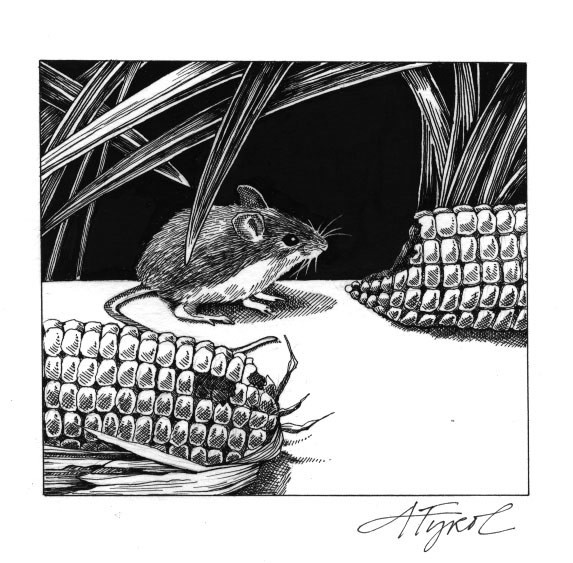
Just as we’ve always suspected, mice do work in shifts. How else could they get so much done? The two most common species of native mice in our region, deer mice and white-footed mice, are both nocturnal, but they prefer to work different hours. White-footed mice take the early shift and are generally active between 7 p.m. and 1 a.m., while deer mice snooze past midnight and then get cracking from about 1 a.m. until 7 a.m. What they do on their respective six-hour shifts is mostly find food and eat it; at this time of year, they are also hiding caches of food.
These two mice look very similar, and both, in fact, have white feet. Deer mice may look somewhat more deer-like, with their large ears, prominent black eyes, tawny brown coats, and white underparts. White-footed mice have more buff or gray in their coats and are slightly larger—they can grow to seven and a half inches in length, compared to the deer mouse’s average length of six to seven inches. In both, the tail accounts for nearly half the body length. Mice of both species weigh approximately an ounce when fully grown. Ideally, they will consume about half an ounce of food every day, and they do not hibernate. In climates like ours, then, they must put by a large store of winter provisions.
Wild mice eat a variety of foods, including insects, spiders, moth and butterfly larvae, seeds, berries, acorns, fruits, and—when they can get it—cultivated grains such as corn and wheat. Deer mice and white-footed mice are good climbers and, like squirrels, often store nuts and seeds in tree cavities. Wild cherry pits and acorns are favorite foods to store, and, during the winter, the nibbled shells of both in a protected spot near the base of a tree are signs that a mouse nest is nearby.
At the same time mice are stocking up for the cold months ahead, they may be raising their last brood of the season. Females can have as many as four litters of young between April and October, with an average of four to six in each litter. They build nests in hollow logs, stone walls, wood piles, tree cavities, outbuildings, and even abandoned birds’ nests. Unlike a bird nest, a mouse nest is covered on the top with an entrance on the side, so a mouse moving into a bird nest must do some remodeling. Mice line their nests with soft plant material such as shredded bark and moss and are always on the lookout for other cushy fibers such as thread or bits of fur.
Newborn mice are altricial—that is to say naked, blind, and helpless. Their eyes and ears are closed at birth, and their skin is so transparent that milk is visible in their stomachs after they nurse. They grow quickly, though, and are weaned by the age of three weeks. After mating, adult mice live separately, but male deer mice do return to the nest to help groom the young and teach them how to find food.
Though mice are prolific breeders, they are also the prey of several larger nocturnal animals, and thus their numbers are kept in check. For many owl species, mice are the mainstay of the diet. Mice are also preyed upon by weasels, snakes, skunks, raccoons, and other animals. For this reason, mice tend to eat in protected places, such as under a rock overhang or among exposed tree roots.
Despite Robert Burns’s characterization of them as “cow’ring, timorous beasties,” however, deer mice and white-footed mice have the right stuff. Not only are they agile climbers, but they are strong swimmers too. And they have a remarkable homing instinct. In a series of experiments at the University of Michigan, white-footed mice captured and then released two miles away routinely found their way back to the very spot where they were captured.
Skeptics aside, rarely do these mice come into our houses in the fall—those are the gray European house mice invading our pantries and building nests between the walls. If you want to spend time in the company of native mice, you need to go outside at night, preferably into a wooded area. You may hear faint scratchings on the trunks of trees or rustlings in the fallen leaves, or possibly the drumming sound mice make by tapping a dry stalk or leaf with their front feet. If you want to know whether you’re hearing a white-footed mouse or a deer mouse, check your watch.

